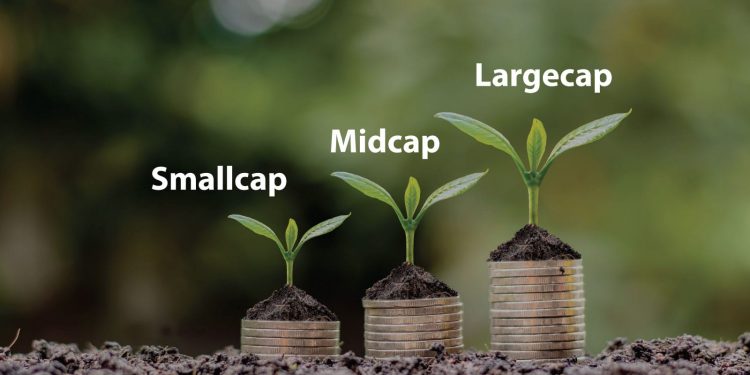There are thousands of companies in the Indian stock market. There are about 2,113 companies listed on the NSE and 5,311 companies listed on the BSE. This means, whether you want to invest in large and midcap funds or small-cap funds, whether you want to opt for mutual funds or even direct equity investments, you are spoilt for choice.
As you can imagine, it can be quite difficult to analyse over 5,000 companies at once. It is much easier to divide them into groups and then do the analysis.
In the stock market, we generally classify companies on the basis of their market size or market capitalisation. Accordingly, there are three types of companies — large-cap companies, mid-cap companies and small-cap companies.
In this article, we will understand the difference between these categories. Let’s get started then, shall we?
First things first. Let’s understand what market capitalisation means and how it is calculated.
What is market capitalisation
This is a measure of the value of the company. We can calculate the market capitalisation of a company by using the following formula.
Market capitalisation = Market price of each share * Total number of outstanding shares
For example, if the share price of company A is ₹100, and there are 1 lakh outstanding shares in the market, then the market capitalisation, according to the formula above is ₹1 crore.
The purpose of calculating the market cap of a company is to see how much it would cost to buy the company in the open market. Now, of course, this isn’t the only method of valuing a company. This is just one of the easiest and one of the most readily available.
On the basis of market capitalisation, we can divide companies into large-cap, mid-cap and small-cap.
What are large-cap companies
Large-cap companies are those that have a market capitalisation of over ₹20,000 crores. These are the 100 largest companies in India, the biggest and the most stable names in the stock market. You can expect to find giants like TCS, Reliance and others in this list.
Now, large-cap companies are known for their stability and their consistency. They have climbed a steep slope to get to the position they have today, and they have already optimised their operational framework.
This means you will not get very aggressive growth. But on the flip side, there is a lower chance of the company going kaput!
You can either invest directly in large-cap stocks or you can opt for a mutual fund.
The advantage of the latter is that you can add some diversification and enjoy a higher growth rate. For example, large and midcap funds invest the corpus amount in large-cap stocks and mid-cap stocks. You will thus get the stability of large-cap stocks and you may also get higher returns.
What are mid-cap companies
Mid-cap companies generally have a market capitalisation between ₹5,000 crores and ₹20,000 crores. The next 150 companies in terms of size, after the large-cap stocks, fall in this range.
As you can imagine, mid-cap stocks grow faster than large-cap stocks. They are in their adolescence, if you will, and are coming into their own potential. These make for very good investments, especially if you stay invested for the long term.
But, these are also more risky than large-cap stocks. As these companies are still growing, their operational procedures have not yet been fully optimised. In normal circumstances, there may not be any issues. However, in special situations, like COVID-19, for instance, mid-cap stocks may be affected.
The selection of the stock is very important when it comes to mid-cap companies. Direct equity investments in this case will require quite a bit of active research and analysis. An easier option is to opt for a midcap fund.
Midcap funds generally invest about 65% of their corpus in midcap companies. The remaining 35% can be in large-cap companies or others. As these funds are professionally managed, there is an entire team for selecting the portfolio. In other words, you can delegate the entire task of selecting and managing the portfolio, and simply enjoy the benefits.
What are small-cap companies
These are the fledglings in the stock market. Small-cap companies typically have a market capitalisation that is less than ₹5,000 crores.
These companies can show aggressive and sometimes even exponential growth. They are discovering themselves and can generate very high returns for the investors. But, small-cap stocks are also the most risky.
The probability of success is not very high, in this case. A lot of small-cap companies can go out of business if they encounter tough market conditions. They don’t have much surplus capital and if things don’t go according to plan, they’ll be forced to shut their doors.
But, if you can identify good small-cap companies, you can essentially end up with a multi-bagger in your hands. It’ll be like investing in Reliance before it became a giant.
Small-cap funds are an easy method of investing in small-cap stocks. Many a time, investors add some proportion of small-cap funds to their portfolio for aggressive growth.
How can you invest
You can invest in two ways — either directly or through mutual funds.
With large-cap stocks, you can go either way. But with mid-cap and small-cap stocks, it is easier to invest through a mutual fund rather than directly. This is for the obvious reason of the risk factor.
Because large-caps have a lower risk element, it is easier to choose individual stocks to invest in. But with mid-caps and small-caps, choosing individual stocks is a long and complicated process. It is much easier to go with a midcap fund or a small-cap fund.
Differences between small-cap, mid-cap and large-cap
Volatility
We keep seeing the prices in the stock market fluctuating like crazy, don’t we? One day the Nifty is up, the next day there is a crash. A different set of companies can do well on the different days of the week.
In other words, a lot is up in the air in the stock market. It is hard to predict what a particular stock will do on a particular day. This is especially true for small-caps.
If we consider volatility to be a spectrum, then large-cap stocks will be at the lower end and small-cap stocks will be at the higher end. Mid-caps, as expected, enjoy a median position. This behaviour can also be seen through the performance of mutual funds. Large-cap funds and mid-cap funds are characterised by much lower volatility than small-cap funds.
If you want to hit the sweet spot, midcap funds are the ideal investment option.
Liquidity
This refers to the ease with which you can enter and exit your investment position. Highly liquid stocks are those that can be bought and sold very easily. They are traded in high volumes, and if you place any orders, those are generally executed instantly.
Now, liquidity arises when there are a lot of shares of that company available in the market. This is the highest for large-cap stocks, followed by mid-caps and then small-caps. Thus, the liquidity factor is also highest for large-cap stocks and lowest for mid-caps.
If you invest through a mutual fund, you don’t really need to worry about this factor. A midcap fund, for instance, will do the buying and selling of shares directly. But, if you invest in individual stocks, the liquidity will dictate how easily you can sell the investment.
Growth potential
This is highest for small-caps and lowest for large-caps. Midcaps, as usual, enjoy a middle ground.
Please note, however, that just because large-caps have lower growth potential, it doesn’t mean they are bad investment options. On the contrary, large-caps are one of the best investment options because they bring stability and security to your portfolio.
Small-cap stocks grow faster because the companies are still adding to their potential and are increasing their proactive capacity every day. Mid-caps, too, have good growth potential.
Risk
Large-cap stocks have the lowest risk exposure, and small-cap stocks have the highest. Midcaps are in the middle. This means if you make an investment in a company or mutual fund, will that investment grow over time or will it fizzle and die out into oblivion?
The chance of that happening is higher with a small-cap, hence the associated risk.
If you invest in mutual funds, the fund manager themselves employ various risk management techniques to ensure that your money is safe. It is for this reason that midcap funds are safer than investing in individual mid-cap stocks.
Conclusion
It is good to have some element of large-cap and mid-cap funds in your portfolio. Midcap funds in particular, because they’re centrally placed, they provide the best of both worlds. You get to enjoy some element of high growth along with a lower risk exposure than small cap funds.
Please make sure, however, that you go through the objectives of the midcap fund scheme and ensure that it mirrors your own investment goals before investing.
Disclaimer: This publication is pursuant to Investor Education and Awareness Initiative by Motilal Oswal Mutual Fund. This shall not be construed as offer to invest in any financial product or Scheme. The objective of this publication is restricted to informational purposes only. All investors have to go through a one-time KYC (Know Your Customer) process. For further details on KYC, Change of address, phone number, bank details etc. list of SEBI registered Mutual Funds and redressal of complaints including details about SEBI SCORES portal, visit link https://www.motilaloswalmf.com//New_Page/KYC-and-Redressal-of-Complaints/9. SMART ODR portal, visit link https://smartodr.in/login. Investors should invest only with SEBI registered Mutual Funds details of which can be verified on the SEBI website under “SEBI Intermediaries/ Market Infrastructure Institutions.
This blog has been issued on the basis of internal data, publicly available information and other sources believed to be reliable. The information contained in this document is for general purposes only and not a complete disclosure of every material fact. The information/data herein alone is not sufficient and shouldn’t be used for the development or implementation of an investment strategy. It should not be construed as investment advice to any party the blog does not warrant the completeness or accuracy of the information and disclaims all liabilities, losses and damages arising out of the use of this information. Mutual Funds are subject to market risk. Read the offer documents before investing. Readers shall be fully responsible/liable for any investment decision taken on the basis of this article.
Mutual Fund investments are subject to market risks, read all scheme related documents carefully.












































